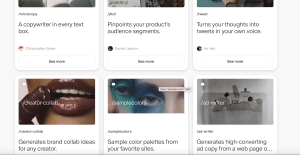Blog Author Marketing Eye Atlanta - Page 1

Marketing Eye Atlanta
Will Dia Browser Kill Google? What the Experts Say
For nearly two decades, Google has been synonymous with search. It became the verb, the default entry point to the internet, and the kingmaker of digital advertising. With over 90 percent global search share, Google’s dominance has felt untouchable. But markets shift. Today, the rise of AI-first browsing tools like Dia Browser raises an uncomfortable question for Google: can its monopoly be challenged?
Experts are split. Some say Google is too entrenched to be dethroned. Others argue that if the browser itself become
How to Choose the Right Marketing Tech Stack for B2B
Selecting the right marketing tech stack for B2B organizations brings long-term benefits to teams focused on growth. With the increasing complexity of digital marketing, many businesses struggle to choose tools that align with their goals. Decision-makers seek reliable solutions for content marketing, digital marketing, web development, lead generation and outsourced marketing. Strategic choices become essential, as effective marketing depends on a blend of technology, process, and expertise. This article addresses key considerations for building a marketing tech stack for optimal agency performance audit outcomes.
Lead Generation That Works: Digital Campaigns That Convert
Efficient lead generation drives consistent business growth. Companies looking for scalable results often prioritize their digital campaigns and lead conversion efforts. Multiple strategic tools have emerged, including PPC advertising, remarketing and CRM lead nurturing. To make the most of digital opportunities, businesses must understand the underlying principles and proven practices that set successful campaigns apart from mediocre ones. The following guide explores the techniques that fuel digital campaigns capable of driving real results.
The Future of AI Marketing: Atlanta’s Path to 2025
Artificial intelligence now dominates conversations about the direction of the marketing industry. In Atlanta, businesses of every size actively consider how machine learning and automation can elevate their strategies. As 2025 approaches, forward-thinking companies seek ways to combine the strength of data with creative campaigns to reach customers.
AI Trends Marketing: Social Media and Atlanta Influencer Marketing Insights
Introduction: Atlanta Social Media AI and the Rise of Intelligent Marketing
Artificial intelligence has established itself in nearly every sector, but its impact on social media marketing in Atlanta stands out. Brands once depended only on creative content and paid ads. Now, AI trends marketing has redefined how businesses engage with their audiences and evaluate success. AI applications like smart targeting, influencer discovery and AI scheduling tools Atlanta offer new pathways for driving real growth. Companies seeking to expand their reach and improve ROI now rely on professional marketing audit agency processes and outsourced marketing solutions.
Why Great Copywriting Matters in AI-Enhanced SEO Campaigns
The Role of Copywriting in the Era of AI-Enhanced SEO
Search engines have become more sophisticated, requiring brands to adapt their content strategies to meet ever-evolving algorithms and user expectations. Great copywriting is the foundation for any successful digital marketing plan and becomes even more significant with AI-enhanced SEO campaigns. High-quality copy not only draws readers in but also supports the SEO content strategy behind each campaign, ensuring content performs well in search ranking. As brands rely on AI copywriting tools and AI marketing software, the partnership between artificial intelligence and skilled human writers leads to better results. Effective copywriting remains essential for bridging technical SEO requirements and real human engagement.
AI-Driven Personalization: Creating Tailored Customer Experiences
Artificial Intelligence: Revolutionizing Personalization
Artificial Intelligence (AI) has become a game-changer for businesses, revolutionizing how they interact with customers. Currently, 88% of marketers are integrating AI into their daily operations, a testament to its widespread acceptance. AI provides unprecedented personalization by analyzing vast amounts of data and delivering relevant content to individual users.
The Rise of Short-Form Video: Capturing Attention in Seconds
With attention spans dwindling, short-form video has emerged as a powerful tool for capturing audience attention quickly and effectively. Whether it's a quick dance tutorial, a behind-the-scenes look, or a product hack, these easily consumable videos transform how brands interact with their target markets.









